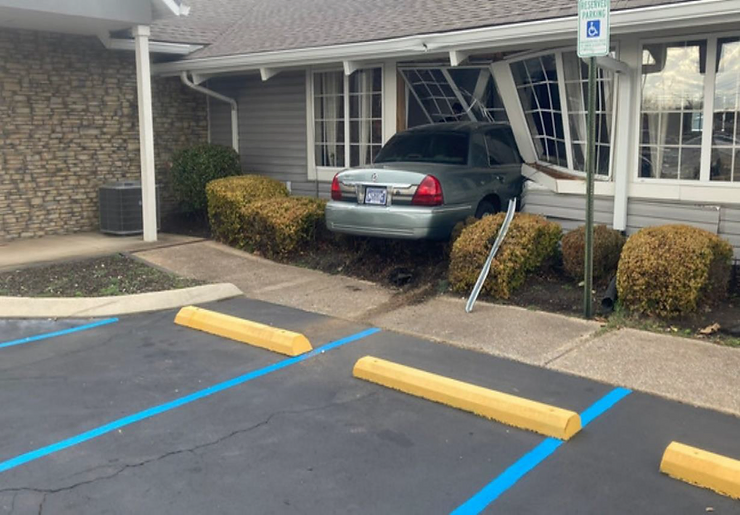What Is Wrong With This Picture?
I review our database of over 28,000 vehicle-into-building crashes monthly. We add approximately 300 storefront crashes and parking lot/pedestrian incidents every month. I also acquire 50 to 75 photos per month, from police reports or media reports – and these photos (like the one above) tell a story in ways that simple data cannot.
Lately I have noticed a great many storefront crashes that originate in nose-in parking spaces designated for ADA drivers only. In many retail centers, and in many designs I see for stand-alone restaurants, convenience stores, and dollar stores, the ADA spaces are in very close proximity to the front doors of the business, and as we all know these doors are often glass and surrounded by windows. In other words, these ADA spaces are pointed directly at the storefront, and very often directly at the entrance where the most customers and employees are likely to be.
Unfortunately, this is a recipe that I see repeated time and time again, which creates a very large percentage of foreseeable, preventable and predictable storefront crashes.
Below is an example of a vehicle that crashed into a Tennessee funeral home. From the inside, all that can be seen is a mangled building and a car inside and lots of damage, as there is no context for the path of the vehicle or anything outside the frame of the photo:
But observed from the outside where the vehicle departed from the parking lot, and we see a fuller explanation for the crash.
This accident was the result of a pedal error on the part of the driver – instead of pressing the brake to slow down, the driver made an error and pressed on the accelerator instead. The vehicle went over the wheel stop, across the sidewalk, flattened the ADA parking sign, and went into the building. These sorts of errors account for as many as 40% of storefront crashes – and are especially prevalent at ADA parking spaces. Because it is foreseeable that a driver parking in a marked ADA space might make some sort of pedal or driver error, it is prudent to remove the wheel stops (which are ineffective to stop vehicles and which are a trip hazard to pedestrians) and replace them with bollards. In this case, perhaps only one bollard used as the signpost might have been enough to stop this vehicle from crashing into the business.
Let’s consider another incident, this time at a furniture store in Louisiana. Again, the vehicle was pulling into a nose-in parking space, clearly marked for drivers and vehicles with ADA placards only. The driver claimed that there was a brake problem of some sort. We see in the photo below that the vehicle has crashed into the glass entrance and destroyed the doors and some of the window glass.
The vehicle penetrated deep enough to strike merchandise inside the store:
As we see the impact from the parking lot view, we see once again that the vehicle has gone over the wheelstop and jumped the curb, and crossed the sidewalk and crashed into the store. As with the previous incident, there is no barrier provided at this higher risk location to prevent a vehicle from overrruning the ADA parking space and crashing into the storefront.
Not surprisingly, I have in my photo library hundreds of vehicles that have jumped wheel stops and curbs and crashed into storefronts, and a surprising percentage of them (like the ones above) have originated in ADA parking spaces. Here are just a few more for reference: Please note that in each of these photos, the ADA parking signs have been run over by the vehicle overrunning the parking space:
We cannot change driver behavior. The causes of accidents have not changed much in the last 20 years, despite efforts by state and local enforcement, federal government policies, and constant reminders to drivers to slow down and be more careful. If we are going to have the same drivers making the same mistakes in the same nose-in parking spaces aimed at glass storefronts and entrances, the one thing that we can control is that we can reduce the threat of harm to customers, employees and pedestrians by preventing the vehicle from leaving the parking lot and crashing onto the pedestrian-only sidewalk or walkway. We do that by installing bollards or safety barriers.
Prevention is affordable, effective, and available. The solution is well known and has been deployed at commercial locations for decades – simple bollards. A risk assessment can be conducted to look at parking lot speeds, paths of vehicle travel, and vulnerabilities of specific locations. From this a competent assessment can determine the threat, determine what sort of bollards or other safety barriers are called for, and the preventive measures can be instituted very effectively and affordably.
Improvements to the safety of storefronts will save money for property owners and businesses because the risk of structural damage or lawsuits from injuries resulting from storefront crashes is eliminated. I am aware of over $250 million in settlements and verdicts that have been paid out in the last few years, and I only see a small fraction of what occurs across the country. Properly installed, bollards comply with ADA, have been crash-tested to meet any requirement for vehicle protection, and are affordable and easily installed.
In a subsequent post, I will go into greater detail on alternatives that comply with ADA have been reviewed by the American Institute or Architects, the American Society of Landscape Architects, various parking organizations, and engineering and design authorities. In the meantime, more than 1,000 of these vehicle-into-building crashes are occurring at unprotected nose-in ADA parking spaces every month. We can do better – we need to prevent these foreseeable risks to the public.














Comentarios